If you’ve ever dropped your bike, you’ll know bent handlebars are a pain. A garage tip-over bent MCM’s long-term Kawasaki Versys’s lefthand bar inwards, so the only course of action was to replace the handlebars. Here’s how we did it…
 1 You can see how the lefthand bar of the Kawasaki Versys has bent inwards and upwards after taking a tumble. The bars took the full force of the impact – no other damage was done.
1 You can see how the lefthand bar of the Kawasaki Versys has bent inwards and upwards after taking a tumble. The bars took the full force of the impact – no other damage was done.
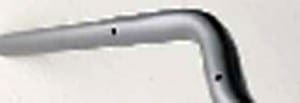 2 If you are buying non-OE bars (those pictured are genuine Kawasaki bars), then check that the holes are pre-drilled – these are the switchgear locating holes. If not, then you will have to measure and then drill them yourself. Also if you are getting different rise bars, check that the new bars fit with your existing bodywork and can turn fully side-to-side without catching on anything. Also check that your existing cables will be long enough and that the diameter of the bars is the same as the stock items (otherwise you may need different clamps).
2 If you are buying non-OE bars (those pictured are genuine Kawasaki bars), then check that the holes are pre-drilled – these are the switchgear locating holes. If not, then you will have to measure and then drill them yourself. Also if you are getting different rise bars, check that the new bars fit with your existing bodywork and can turn fully side-to-side without catching on anything. Also check that your existing cables will be long enough and that the diameter of the bars is the same as the stock items (otherwise you may need different clamps).
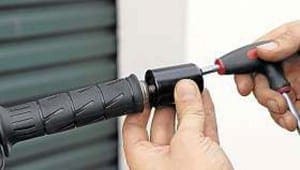
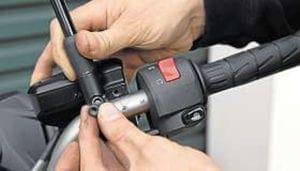

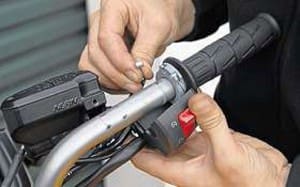 3 Starting with the throttle (right hand) side, remove bar end weight (some will need a screwdriver, some an Allen key – the Versys needed a 6mm Allen key). Then remove the brake reservoir mountings (on the Versys, the mirror was attached to the clamp). Remove any fasteners, eg cable retainers then undo the throttle twistgrip switchgear. You may need to undo the bars at the clamp at this point to allow room for the twist grip and throttle cable to be removed. Lay cables and switchgear housing to one side – protect bodywork with a cloth.
3 Starting with the throttle (right hand) side, remove bar end weight (some will need a screwdriver, some an Allen key – the Versys needed a 6mm Allen key). Then remove the brake reservoir mountings (on the Versys, the mirror was attached to the clamp). Remove any fasteners, eg cable retainers then undo the throttle twistgrip switchgear. You may need to undo the bars at the clamp at this point to allow room for the twist grip and throttle cable to be removed. Lay cables and switchgear housing to one side – protect bodywork with a cloth.
 4 Now on the clutch (left-hand) side, remove bar end weight as before. If you are replacing grips, you can just cut the grip off but if not (like us), you need to remove the grip carefully so as not to damage it (you can’t slide it off as per the throttle side as the throttle side grip is mounted to the twist grip tube). The best way is to lift up the grip with a screwdriver and use either soapy water or GT85 to loosen it. Only use non-petroleum based lubricants as you don’t want to dissolve the rubber.
4 Now on the clutch (left-hand) side, remove bar end weight as before. If you are replacing grips, you can just cut the grip off but if not (like us), you need to remove the grip carefully so as not to damage it (you can’t slide it off as per the throttle side as the throttle side grip is mounted to the twist grip tube). The best way is to lift up the grip with a screwdriver and use either soapy water or GT85 to loosen it. Only use non-petroleum based lubricants as you don’t want to dissolve the rubber.
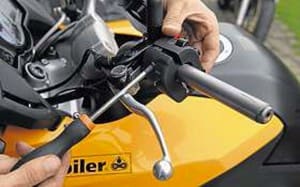 5 Again, remove switchgear by undoing the retaining screws and any cable fasteners.
5 Again, remove switchgear by undoing the retaining screws and any cable fasteners.
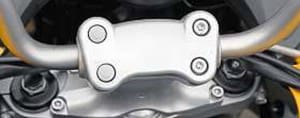 6 Remove Allen bolt covering plugs from the bar’s bolts (if your bike has them, like the Versys does). Then undo the bar clamps and remove the bars.
6 Remove Allen bolt covering plugs from the bar’s bolts (if your bike has them, like the Versys does). Then undo the bar clamps and remove the bars.
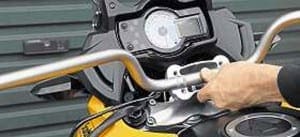 7 Offer up the new bars and centralise them (bars normally have location markings on to help with this).
7 Offer up the new bars and centralise them (bars normally have location markings on to help with this).
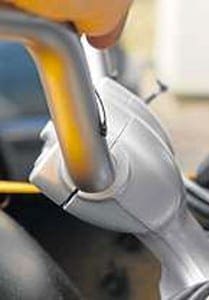 8 Put the clamp back in place over the bars and do up Allen bolts to secure the bars. Each bolt should be done up to the same tension – you want an even gap between the edges of the clamp, not an uneven gap (as pictured).
8 Put the clamp back in place over the bars and do up Allen bolts to secure the bars. Each bolt should be done up to the same tension – you want an even gap between the edges of the clamp, not an uneven gap (as pictured).
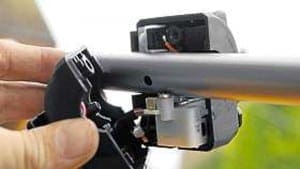 9 Do the bars up so they are reasonably tight, but not so tight as to fully secure the bars yet as they most likely need to be further adjusted. When putting the switchgear back on, ensure the locating peg in the back of the switchgear goes into its locating hole in the bars, otherwise the switchgear won’t sit correctly.
9 Do the bars up so they are reasonably tight, but not so tight as to fully secure the bars yet as they most likely need to be further adjusted. When putting the switchgear back on, ensure the locating peg in the back of the switchgear goes into its locating hole in the bars, otherwise the switchgear won’t sit correctly.
 10 On the left-hand side, refit the grip with the aid of soapy water – you can also use a little brake cleaner to help. Never use lubricant such as WD40 because the grip will then move around. Then screw on bar end weight and relocate cables in the correct place.
10 On the left-hand side, refit the grip with the aid of soapy water – you can also use a little brake cleaner to help. Never use lubricant such as WD40 because the grip will then move around. Then screw on bar end weight and relocate cables in the correct place.
 11 Swapping over to the throttle (right-hand) side, refit switchgear. When reconnecting the throttle cables, ensure you’ve not twisted or mis-routed them. The throttle should snap back crisply from fully open when you release it. The throttle cable should lie smooth without any kinks. Again, ensure switchgear locating dowel is inside its hole – screws should be tight enough so that the switchgear doesn’t move, but don’t overtighten them as you could damage the thread or the head of the fastener.
11 Swapping over to the throttle (right-hand) side, refit switchgear. When reconnecting the throttle cables, ensure you’ve not twisted or mis-routed them. The throttle should snap back crisply from fully open when you release it. The throttle cable should lie smooth without any kinks. Again, ensure switchgear locating dowel is inside its hole – screws should be tight enough so that the switchgear doesn’t move, but don’t overtighten them as you could damage the thread or the head of the fastener.
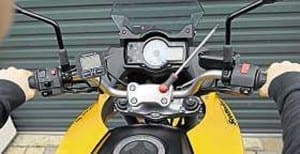 12 Set bar position according to preference. When happy, tighten the bar clamp up and refit any Allen bolt covering plugs (if fitted). Turn the bars fully from side to side to check for any interference or steering lock issues.
12 Set bar position according to preference. When happy, tighten the bar clamp up and refit any Allen bolt covering plugs (if fitted). Turn the bars fully from side to side to check for any interference or steering lock issues.
Why choose aftermarket bars?
- Better range of adjustability
- Higher-grade metal for increased strength and durability
- Superior CNC machining quality and higher-quality finishing
- Weight saving
- Different bar size/width/rise/style (e.g making a Aprilia Falco into a streetfighter with higher bars)
- Different colours and finishes available


